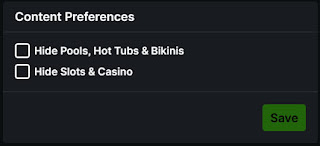Live streaming platforms have experienced tremendous growth in recent years, providing a platform for content creators to engage with their audiences and showcase a wide variety of content. With this rapid expansion comes a need to address the diverse preferences and sensitivities of users. Recently, Kick Live Streaming introduced a Content Preferences feature that allows users to hide specific directory feeds like "Pools, Hot Tubs & Bikinis" and "Slots & Casino."
In light of this move, it begs the question: should Twitch, one of the largest live streaming platforms, replicate a similar feature that allows users to filter out channels based on content labeling? To answer this, we must delve into the recent content labeling system that Twitch has introduced and consider the potential benefits and challenges of implementing such a feature.
Twitch's Content Labeling System
Twitch has taken a step towards making the platform more AD + user-friendly by introducing a content labeling system. This system allows streamers to set warning labels based on the content they intend to feature during their streams. The labels include categories such as:
- Drugs, Intoxication, or Excessive Tobacco Use
- Gambling
- Mature-rated game
- Significant Profanity or Vulgarity
- Sexual Themes
- Violent and Graphic Depictions
Kick's Content Preferences Feature
Kick Live Streaming has taken a different approach by introducing a Content Preferences feature that allows users to hide specific directory feeds. This enables users to avoid certain types of content that they may find objectionable or simply not of interest. For example, users can hide feeds related to "Pools, Hot Tubs & Bikinis" and "Slots & Casino."
The Argument for Twitch Replicating Kick's Feature
The introduction of Kick's Content Preferences feature raises an interesting question: should Twitch replicate this feature to give users more control over their content discovery experience? There are several reasons why this could be a beneficial addition to the Twitch platform:
- Enhanced User Experience: Empowering users to filter out content that does not align with their preferences creates a more enjoyable and personalized experience. Users can avoid content that may make them uncomfortable or that they have no interest in.
- Content Moderation: Allowing users to customize their content discovery can serve as a form of self-moderation. This may reduce the burden on Twitch's content moderation team by giving viewers more control over what they see.
- Inclusivity and Respect for Diverse Audiences: Different users have diverse tastes and sensitivities. Giving users the ability to tailor their experience to their preferences promotes inclusivity and respect for a wide range of audiences.
While the idea of replicating Kick's Content Preferences feature on Twitch has its merits, it also comes with potential challenges and counterarguments:
- Impact on Streamers: Streamers may be concerned that the filtering feature could limit their reach and audience size, especially if their content falls into categories that some users choose to filter out.
- Finding the Right Balance: Balancing the needs and preferences of both viewers and content creators can be challenging. Implementing such a system would require careful consideration to strike the right balance.
- Potential for Abuse: There is a risk that some users may misuse the filtering feature to target specific streamers or types of content, potentially leading to unfair consequences for creators.
The introduction of Kick's Content Preferences feature and Twitch's content labeling system demonstrate that live streaming platforms are taking steps to enhance the user experience and provide more transparent content warnings. The idea of Twitch replicating Kick's feature is intriguing, as it could offer viewers more control over their content discovery. However, it also comes with challenges that must be carefully addressed. Striking a balance that respects the diverse needs of both viewers and content creators while preventing potential misuse is crucial. Ultimately, the decision should be made with the goal of creating a more inclusive and enjoyable environment for all users.
